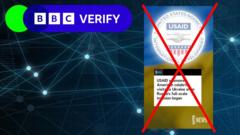A video circulating on social media alleges that USAID, the U.S. government's primary agency for overseas aid, has financially compensated Hollywood celebrities to make visits to Ukraine. This claim has garnered significant attention, with prominent figures such as Elon Musk amplifying its reach. However, a closer examination reveals that the video lacks authenticity and shares characteristics typically associated with Russian disinformation efforts. BBC Verify journalist Olga Robinson provided insights on the misleading nature of the video, highlighting the importance of critically assessing information before accepting it as fact. The video appears crafted to serve an agenda, drawing on the notoriety of high-profile individuals to propagate its misleading narrative. With increasing scrutiny on misinformation, the case serves as a reminder of the need for vigilance in consuming media, especially on platforms prone to sensationalism and fabrication.
Viral Video Disinformation: Claims of Hollywood Stars Paid by USAID to Visit Ukraine

Viral Video Disinformation: Claims of Hollywood Stars Paid by USAID to Visit Ukraine
A misleading video alleging that USAID funded Hollywood celebrities to visit Ukraine has gained traction online, despite being debunked as a false narrative.
A viral video falsely claims USAID paid Hollywood stars to visit Ukraine, echoing a disinformation strategy. Despite its spread, including endorsements from influential figures like Elon Musk, the clip has been identified as a falsehood by BBC investigations.
A video circulating on social media alleges that USAID, the U.S. government's primary agency for overseas aid, has financially compensated Hollywood celebrities to make visits to Ukraine. This claim has garnered significant attention, with prominent figures such as Elon Musk amplifying its reach. However, a closer examination reveals that the video lacks authenticity and shares characteristics typically associated with Russian disinformation efforts. BBC Verify journalist Olga Robinson provided insights on the misleading nature of the video, highlighting the importance of critically assessing information before accepting it as fact. The video appears crafted to serve an agenda, drawing on the notoriety of high-profile individuals to propagate its misleading narrative. With increasing scrutiny on misinformation, the case serves as a reminder of the need for vigilance in consuming media, especially on platforms prone to sensationalism and fabrication.













